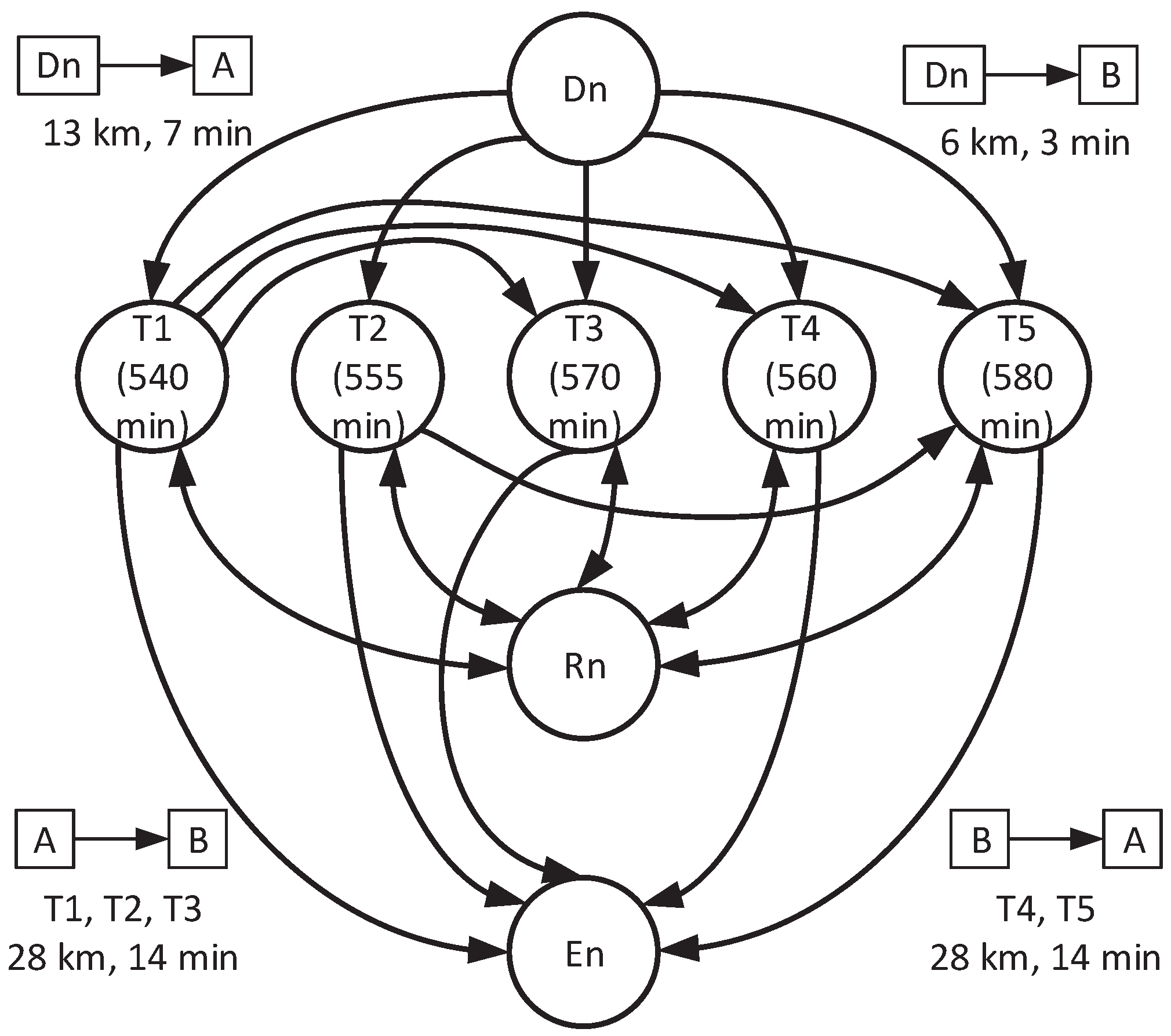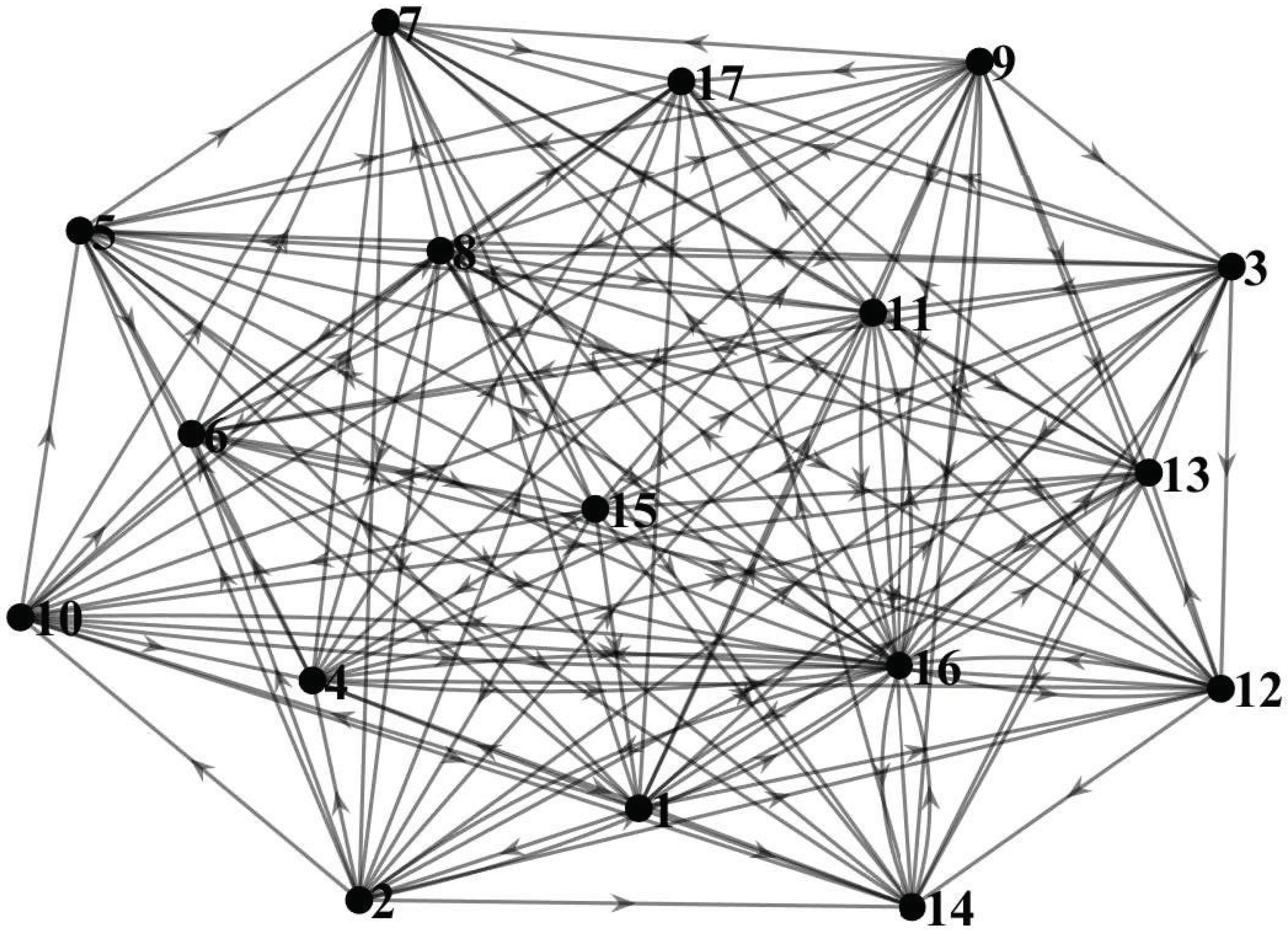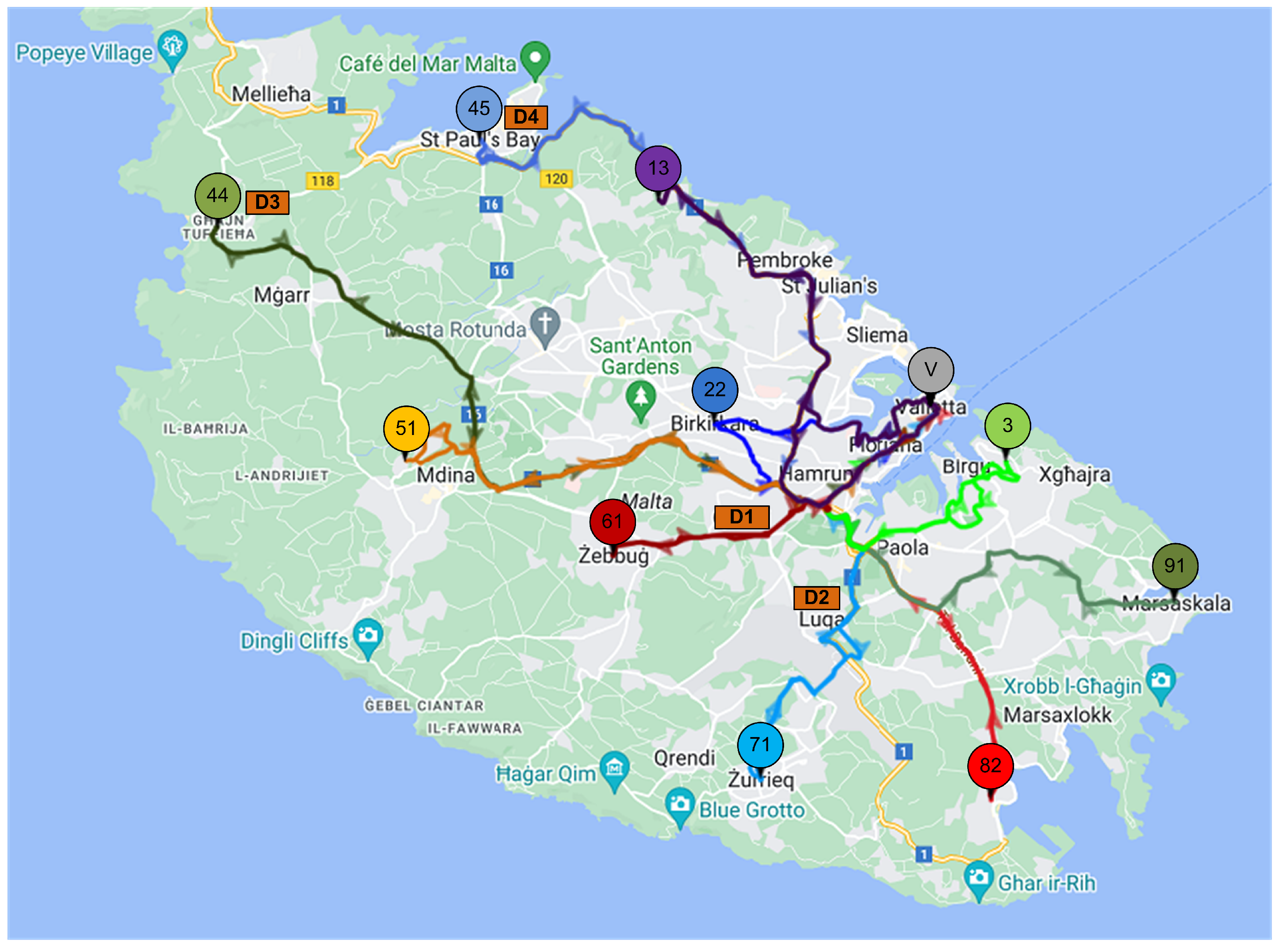Optimizing the Scheduling of Electrified Public Transport System in Malta †
Abstract
1. Introduction
- The objective of minimizing the usage costs and fixed recharging costs is completed using mixed-integer linear programming;
- A multi-agent solution that is more accommodating to more objectives is proposed in this paper. The solution relies on communication within predefined agents;
- A comparative analysis is conducted between the classical optimization method and the multi-agent-based solution. A toy problem was solved for comparing the two methods. The latter method was then extended to provide the optimal number of buses required for the timetabled trips.
2. Literature Review
3. Public Transport Optimization Framework
4. Multi-Agent Framework
4.1. Agent Types
4.1.1. Bus Agent (BA)
4.1.2. Depot Agent (DA)
4.1.3. Manager Agent (MA)
4.2. Strategies and Tasks of Agents
4.2.1. Strategies and Tasks of MA
- Step 1
- Broadcast the next trip information from the bus timetable to all BAs. The information contains the trip starting time and the route of the trip from starting station to terminating station.
- Step 2
- Receive the operating costs to fulfil the trip from the BAs who can make the trip.
- Step 3
- Dispatch the BA with minimum cost to realise the trip.
4.2.2. Strategies and Tasks of BAs
- Step 1
- Receive the message from MA for the next scheduled trip information and starting time.
- Step 2
- Check for the time feasibility to reach the starting station of the scheduled trip from current location. If yes, go to Step 3. Otherwise, do not respond to MA.
- Step 3
- Check for range feasibility that enough range is available to cover the following distances
- Current location to starting station
- Trip distance
- Terminating stop to nearby depot.
If enough range is available, go to Step 4. Otherwise, do not respond to MA and go to Step 5. - Step 4
- Calculate the operating cost to make the scheduled trip and send the cost to MA. Operating cost = deadhead cost + trip cost
- Step 5
- Check if further trips can be realised with the currently available range. If yes, wait at the current location. Otherwise, go to Step 6.
- Step 6
- Communicate with DAs for the parking and charging space availability. Make a decision based on the DAs’ information and go to the nearby available depot for charging.
4.2.3. Strategies and Tasks of DAs
- Step 1
- Receive the message from BAs for parking or charging spots.
- Step 2
- Communicate with BA and provide the information about the available parking and charging space.
- Step 3
- Make the decision about the disconnection of BAs from charging to maintain a minimum waiting time for charging the other BAs.
5. Results and Discussion
5.1. Toy Example: One Depot and Five Trips between Points A and B
5.2. Single Depot and Fourteen Trips between Points A and B
5.3. Malta’s Public Transport Network
5.4. Case 1
5.5. Case 2
5.6. Case 3
5.7. Case 4
6. Conclusions
Author Contributions
Funding
Conflicts of Interest
References
- Saha, J. An Algorithm for Bus Scheduling Problems. J. Oper. Res. Soc. 1970, 21, 463–474. [Google Scholar] [CrossRef]
- Boren, S. Electric buses’ sustainability effects, noise, energy use, and costs. Int. J. Sustain. Transp. 2020, 14, 956–971. [Google Scholar] [CrossRef]
- ABB. Electric Bus Pantograph Up. Available online: https://new.abb.com/ev-charging/pantograph-up (accessed on 27 May 2023).
- Bakker, S.; Konings, R. The transition to zero-emission buses in public transport—The need for institutional innovation. Transp. Res. Part D Transp. Environ. 2018, 64, 204–215. [Google Scholar] [CrossRef]
- Jagiełło, A.; Wołek, M.; Bizon, W. Comparison of Tender Criteria for Electric and Diesel Buses in Poland—Has the Ongoing Revolution in Urban Transport Been Overlooked? Energies 2023, 16, 4280. [Google Scholar] [CrossRef]
- Teng, J.; Jin, S.; Lai, X.; Chen, S. Vehicle-Scheduling Model for Operation Based on Single-Depot. Math. Probl. Eng. 2015, 2015, 506794. [Google Scholar] [CrossRef]
- Freling, R.; Wagelmans, A.P.M.; Paixão, J.M.P. Models and Algorithms for Single-Depot Vehicle Scheduling. Transp. Sci. 2001, 35, 165–180. [Google Scholar] [CrossRef]
- Zhang, J.; Li, W.; Qiu, F. Optimizing Single-Depot Vehicle Scheduling Problem: Fixed-Interval Model and Algorithm. J. Intell. Transp. Syst. 2015, 19, 215–224. [Google Scholar] [CrossRef]
- Kang, L.; Chen, S.; Meng, Q. Bus and driver scheduling with mealtime windows for a single public bus route. Transp. Res. Part C Emerg. Technol. 2019, 101, 145–160. [Google Scholar] [CrossRef]
- Zhou, G.J.; Xie, D.F.; Zhao, X.M.; Lu, C. Collaborative Optimization of Vehicle and Charging Scheduling for a Bus Fleet Mixed With Electric and Traditional Buses. IEEE Access 2020, 8, 8056–8072. [Google Scholar] [CrossRef]
- Sundstȑom, O.; Binding, C. Optimization Methods to Plan the Charging of Electric Vehicle Fleets; IBM Research: Zurich, Switzerland, 2010. [Google Scholar]
- Xu, X.; Yu, Y.; Long, J. Integrated electric bus timetabling and scheduling problem. Transp. Res. Part C Emerg. Technol. 2023, 149, 104057. [Google Scholar] [CrossRef]
- Wilson, W.; Venkataramanan, M.; Goldberg, J. Introduction to Mathematical Programming; MIT Press: Cambridge, MA, USA, 2003. [Google Scholar]
- Duan, M.; Liao, F.; Qi, G.; Guan, W. Integrated optimization of electric bus scheduling and charging planning incorporating flexible charging and timetable shifting strategies. Transp. Res. Part C Emerg. Technol. 2023, 152, 104175. [Google Scholar] [CrossRef]
- Dasović, B.; Klanšek, U. A Review of Energy-Efficient and Sustainable Construction Scheduling Supported with Optimization Tools. Energies 2022, 15, 2330. [Google Scholar] [CrossRef]
- Meng, G.; Lai, Y.; Yang, F. An Optimal Bus Scheduling Model Based on Mixed-Integer Linear Programming. In Proceedings of the 2020 IEEE 9th Joint International Information Technology and Artificial Intelligence Conference (ITAIC), Chongqing, China, 11–13 December 2020; Volume 9, pp. 2200–2204. [Google Scholar]
- Zhang, J.; Jiang, Q.; Pan, A.; Li, T.; Liu, Z.; Zhang, Y.; Jiang, L.; Zhan, X. An Optimal Dispatching Strategy for Charging and Discharging of Electric Vehicles Based on Cloud-Edge Collaboration. In Proceedings of the 2021 3rd Asia Energy and Electrical Engineering Symposium (AEEES), Chengdu, China, 26–29 March 2021; pp. 827–832. [Google Scholar]
- Li, W.; Ding, Y.; Yang, Y.; Sherratt, R.S.; Park, J.H.; Wang, J. Parameterized algorithms of fundamental NP-hard problems: A survey. Hum.-Centric Comput. Inf. Sci. 2020, 10, 1–24. [Google Scholar] [CrossRef]
- Sun, B. Optimal Bus Scheduling Considering Operating Costs and Emissions: A Multiple Objective, Mixed Integer Programming Framework. Master’s Thesis, University of Minnesota, Minneapolis, MN, USA, 2015. [Google Scholar]
- Jahic, A.; Plenz, M.; Eskander, M.; Schulz, D. Route Scheduling for Centralized Electric Bus Depots. IEEE Open J. Intell. Transp. Syst. 2021, 2, 149–159. [Google Scholar] [CrossRef]
- Schiewe, P.; Stinzendörfer, M. Integrated Line Planning and Vehicle Scheduling for Public Transport. In Proceedings of the International Network Optimization Conference, Aachen, Germany, 7–10 June 2022. [Google Scholar]
- Kunith, A.; Mendelevitch, R.; Goehlich, D. Electrification of a city bus network—An optimization model for cost-effective placing of charging infrastructure and battery sizing of fast-charging electric bus systems. Int. J. Sustain. Transp. 2017, 11, 707–720. [Google Scholar] [CrossRef]
- Yao, E.; Liu, T.; Lu, T.; Yang, Y. Optimization of electric vehicle scheduling with multiple vehicle types in public transport. Sustain. Cities Soc. 2020, 52, 101862. [Google Scholar]
- Lin, H.; Tang, C. Analysis and Optimization of Urban Public Transport Lines Based on Multiobjective Adaptive Particle Swarm Optimization. IEEE Trans. Intell. Transp. Syst. 2022, 23, 16786–16798. [Google Scholar] [CrossRef]
- Verbrugge, B.; Rauf, A.M.; Rasool, H.; Abdel-Monem, M.; Geury, T.; Baghdadi, M.E.; Hegazy, O. Real-Time Charging Scheduling and Optimization of Electric Buses in a Depot. Energies 2022, 15, 5023. [Google Scholar] [CrossRef]
- Sharma, S.; Bhattacharya, S.; Kiran, D.; Hu, B.; Prandtstetter, M.; Azzopardi, B. A multi-agent framework for scheduling fully electrified public transport. In Proceedings of the 13th Mediterranean Conference on Power Generation, Transmission, Distribution and Energy Conversion (MEDPOWER 2022), Valletta, Malta, 7–9 November 2022; pp. 571–574. [Google Scholar] [CrossRef]
- Malta Public Transport Network Offline Map in PDF. Available online: https://moovitapp.com/index/en-gb/public_transportation-Offline_maps_Malta_Public_Transport_Network-map-Malta-4507-5291 (accessed on 27 May 2023).




| Approaches | Ref. | Key Points | Issues |
|---|---|---|---|
| Heuristics | [7,10] | Combined auction | NP-hard |
| Classical Optimizers | [20,21,22] | Exactness in the solution | Polynomial combinations |
| Evolutionary Computation | [23,24,25] | Accommodative to non-differentiable heuristics | Global optimality not gauranteed |
| Bus 1 | Bus 2 | Bus 3 | ||||||
|---|---|---|---|---|---|---|---|---|
| Route | (km) | (min) | Route | (km) | (min) | Route | (km) | (min) |
| 6 | 100 | 533 | 6 | 100 | 548 | 6 | 100 | 567 |
| 1 | 59 | 554 | 2 | 59 | 569 | 3 | 59 | 584 |
| 4 | 31 | 574 | 5 | 31 | 594 | 8 | 53 | 587 |
| 8 | 18 | 581 | 8 | 18 | 601 | |||
| Bus 1 | Route | 15 | 8 | 2 | 3 | 11 | 5 | 16 | 13 | 7 | 17 |
| t (min) | 297 | 376.5 | 497.5 | 695 | 847.5 | 977.5 | 1040.5 | 1200.5 | 1297.5 | 1330.5 | |
| s (km) | 100 | 76.5 | 64 | 39 | 26.5 | 14 | 3 | 76.5 | 64 | 53 | |
| Bus 2 | Route | 15 | 1 | 9 | 10 | 4 | 16 | 12 | 6 | 14 | 17 |
| t (min) | 276 | 337.5 | 527.5 | 725 | 817.5 | 880.5 | 1040.5 | 1137.5 | 1327.5 | 1351.5 | |
| s (km) | 100 | 79.5 | 67 | 42 | 29.5 | 18.5 | 76.5 | 64 | 51.5 | 43.5 |
| Bus 1 | Route | 15 | 1 | 9 | 3 | 11 | 5 | 16 | 13 | 7 | 17 |
| t (min) | 276 | 337.5 | 527.5 | 657.5 | 847.5 | 977.5 | 1040.5 | 1167.5 | 1297.5 | 1330.5 | |
| s (km) | 100 | 79.5 | 67 | 54.5 | 42 | 29.5 | 18.5 | 76.5 | 64 | 53 | |
| Bus 2 | Route | 15 | 8 | 2 | 10 | 4 | 12 | 6 | 16 | 14 | 17 |
| t (min) | 297 | 367.5 | 497.5 | 687.5 | 817.5 | 1007.5 | 1137.5 | 1200.5 | 1327.5 | 1351.5 | |
| s (km) | 100 | 76.5 | 64 | 51.5 | 39 | 26.5 | 14 | 3 | 76.5 | 68.5 |
| S. No. | Bus Route | Length of Route (km) | Starting Station | Terminating Station |
|---|---|---|---|---|
| 1 | 71 | 12.5 | Valletta | Zurrieq |
| 2 | 82 | 13.5 | Valletta | Birzebugga |
| 3 | 13 | 17.4 | Valletta | Bahar Ic Caghaq |
| 4 | 3 | 12 | Valletta | Kalkara |
| 5 | 91 | 14.1 | Valletta | Marsaskala |
| 6 | 44 | 20.4 | Valletta | Ghajn Tuffieha |
| 7 | 45 | 17.5 | Valletta | Bugibba |
| 8 | 51 | 13.4 | Valletta | Mtarfa |
| 9 | 61 | 10.2 | Valletta | Zebbug |
| 10 | 22 | 7.9 | Valletta | Birkirkara |
| Type | Range (km) | Recharging Rate (km per min) | Operating Cost | |
|---|---|---|---|---|
| Deadheading (EUR/km) | On Route (EUR/km) | |||
| EV1 | 170 | 3.3 | 0.77 | 0.84 |
| EV2 | 120 | 4 | 0.63 | 0.7 |
| Features | Case 1 | Case 2 | Case 3 | Case 4 | ||||||||
|---|---|---|---|---|---|---|---|---|---|---|---|---|
| Total Buses | EV1 Buses | EV2 Buses | Total Buses | EV1 Buses | EV2 Buses | Total Buses | EV1 Buses | EV2 Buses | Total Buses | EV1 Buses | EV2 Buses | |
| Number of buses | 74 | 40 | 34 | 67 | 40 | 27 | 72 | 40 | 32 | 65 | 40 | 25 |
| Operating costs (EUR) | 11,232.49 | 7407.00 | 3825.49 | 11,038.43 | 6660.81 | 4377.62 | 11,245.58 | 7476.28 | 3769.30 | 11,121.17 | 7040.89 | 4080.28 |
| Total distance (km) | 14,418.40 | 8869.60 | 5548.80 | 14,304.60 | 7995.50 | 6309.10 | 14,421.30 | 8950.00 | 5471.30 | 14,335.30 | 8448.40 | 5886.90 |
| Average distance (km) | 194.84 | 221.74 | 163.20 | 213.50 | 199.89 | 233.67 | 200.30 | 223.75 | 170.98 | 220.54 | 211.21 | 235.48 |
| Average deadheading distance (km) | 19.72 | 15.52 | 24.65 | 20.08 | 19.79 | 20.50 | 20.30 | 14.90 | 27.06 | 21.17 | 19.92 | 23.17 |
| Average enroute distance (km) | 175.13 | 206.22 | 138.55 | 193.42 | 180.10 | 213.17 | 179.99 | 208.85 | 143.92 | 199.38 | 191.30 | 212.30 |
| Average charging breaks | 1.09 | 1.00 | 1.21 | 1.23 | 0.93 | 1.67 | 1.15 | 1.00 | 1.34 | 1.23 | 0.90 | 1.76 |
Disclaimer/Publisher’s Note: The statements, opinions and data contained in all publications are solely those of the individual author(s) and contributor(s) and not of MDPI and/or the editor(s). MDPI and/or the editor(s) disclaim responsibility for any injury to people or property resulting from any ideas, methods, instructions or products referred to in the content. |
© 2023 by the authors. Licensee MDPI, Basel, Switzerland. This article is an open access article distributed under the terms and conditions of the Creative Commons Attribution (CC BY) license (https://creativecommons.org/licenses/by/4.0/).
Share and Cite
Sharma, S.; Bhattacharya, S.; Kiran, D.; Hu, B.; Prandtstetter, M.; Azzopardi, B. Optimizing the Scheduling of Electrified Public Transport System in Malta. Energies 2023, 16, 5073. https://doi.org/10.3390/en16135073
Sharma S, Bhattacharya S, Kiran D, Hu B, Prandtstetter M, Azzopardi B. Optimizing the Scheduling of Electrified Public Transport System in Malta. Energies. 2023; 16(13):5073. https://doi.org/10.3390/en16135073
Chicago/Turabian StyleSharma, Satish, Somesh Bhattacharya, Deep Kiran, Bin Hu, Matthias Prandtstetter, and Brian Azzopardi. 2023. "Optimizing the Scheduling of Electrified Public Transport System in Malta" Energies 16, no. 13: 5073. https://doi.org/10.3390/en16135073
APA StyleSharma, S., Bhattacharya, S., Kiran, D., Hu, B., Prandtstetter, M., & Azzopardi, B. (2023). Optimizing the Scheduling of Electrified Public Transport System in Malta. Energies, 16(13), 5073. https://doi.org/10.3390/en16135073







